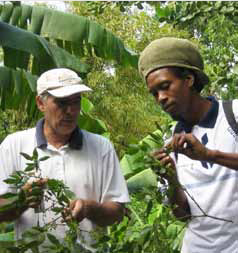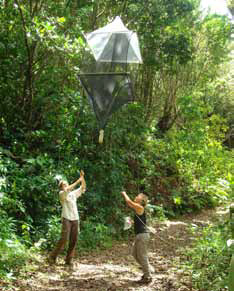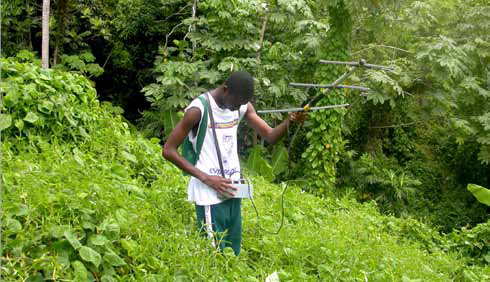
The National Forest Demarcation & BioPhysical Resource Inventory
OverviewThe Ministry of Agriculture, Lands, Fisheries and Forestry (MAFF) of Saint Lucia promotes and supports the conservation of the country’s natural resource base for the benefit of the entire population. The Forestry Department, in collaboration with the Crown Lands Division of the Ministry of Physical Development and National Mobilization, has identified all the lands adjacent to the Forest Reserves and has made recommendations for their acquisition and eventual incorporation into the existing Forest Reserve Management System. However, before reaching that point, these lands have to be surveyed, demarcated on the ground with standard physical markers, vested in the Crown or acquired, and declared legal Forest Reserves. In addition, the existing forest reserve boundaries need to be re-demarcated.
The overall objective of the project was to survey and demarcate the physical parameters of the public forest reserve and to conduct a comprehensive assessment of the biophysical inventory and management system of forest resources to produce, inter alia, a forest resource monitoring system. The data from this assessment would be obtained through ground surveys, remote sensing, and the assessment and review of existing data that will serve as the basis for strategic sustainable planning and management of forest resources.

The National Forest Demarcation & Bio-Physical Resource Inventory programme was an ambitious one and was divided into sub categories. Below is a list of accomplishments of the project:

- An updated database of Forest Reserve boundary lines (digital and hard copy data to reside at Forestry Department and Lands and Surveys Department) and measurement of the quality, quantity and distribution – inclusive of yield and volume – of timber and non-timber resources, and the compilation of statistics which reflect their availability at the range, watershed and national level
- The assessment of the forest ecosystem, biodiversity (species richness and diversity) and all existing vegetation type at the watershed, range, and national level
- The assessment of all existing forestry related database with the intention of creating an updated monitoring system for producing forest resource state and change estimates
- The determination of the most optimal means/measures for the sustainable management (utilization and conservation) of forest resources
- Survey, demarcation and realignment of the forest reserves boundaries incorporating the newly acquired crown lands, in order to facilitate better protection and management
- A training programme to develop the capacity of a cadre of persons in forests resource assessment and inventory method and forests management system using, scientific and modern technology. This was conducted and an effective, efficient and appropriate forest management system for Saint Lucia was first recommended and then implemented
- Relevant civil, cultural and utilization prescriptions necessary for planning and management of forest resources were also recommended at the close of the programme by experts who formed a part of the team.
The Forestry Department is the principle agency responsible for managing forest and wildlife resources on the island of Saint Lucia. The Forestry Division of Saint Lucia was established in 1946, upgraded to the status of Forestry Department in 1984 and is currently supervised by the Chief Forestry Officer. This project was funded by the European Community under the Saint Lucia SFA 2003 Programme Economic and Agriculture Diversification and Poverty Reduction through Integrated National Resources Management. The BIT was the Grant Beneficiary and Manager of a component of the Programme, “The Environmental Management Fund”. The contract was awarded to the Consortium of FCG International Ltd., – Finland and AFC Consultants International GmbHGermany –as a joint venture. The project commenced in July 2008 and began the Final Phase, in the fourth quarter of 2009.
The period of work was one of intensive data analysis and reporting by the projects extensive team of more than twent (20) biologists under the direction of the Conservation Biologist. The main activities, with some key preliminary findings, are listed below. A number of specific reports has been prepared, the first of which, a report on the mammals of Saint Lucia, has been released. The goals and purposes of the programme were successfully met with the implementation of a number of differing sub-projects:
- A study of the mammals of Saint Lucia
- The status and management of Saint Lucia’s forests’ reptiles and amphibians
- The classification of the vegetation of Saint Lucia
- The important plants of Saint Lucia: Botanical descriptions and species checklist
- Insects of Saint Lucia: study and report
- Wildlife use in Saint Lucia
- Herbarium and training report
- Critical species report
- Summary of biodiversity values and recommendations.



The forest reserves, comprising mainly rainforest ecosystems, are regarded as exceptionally well preserved. Preliminary findings from the National Forest Demarcation and Bio-Physical Resource Inventory Project (2009) highlight the incredible diversity of Saint Lucia’s forest types (habitats) which support a great variety of species. Few islands can match Saint Lucia’s diversity of forest species, as an exceptionally high number of species exist only on Saint Lucia: nine (9) endemic „higher plant’, six (6) endemic birds (11 subspecies), seven (7) endemic reptiles (5 sub-species), one (1) endemic amphibian, one (1) endemic mammal (1 sub-species) and more than two hundred (200) endemic beetles.
